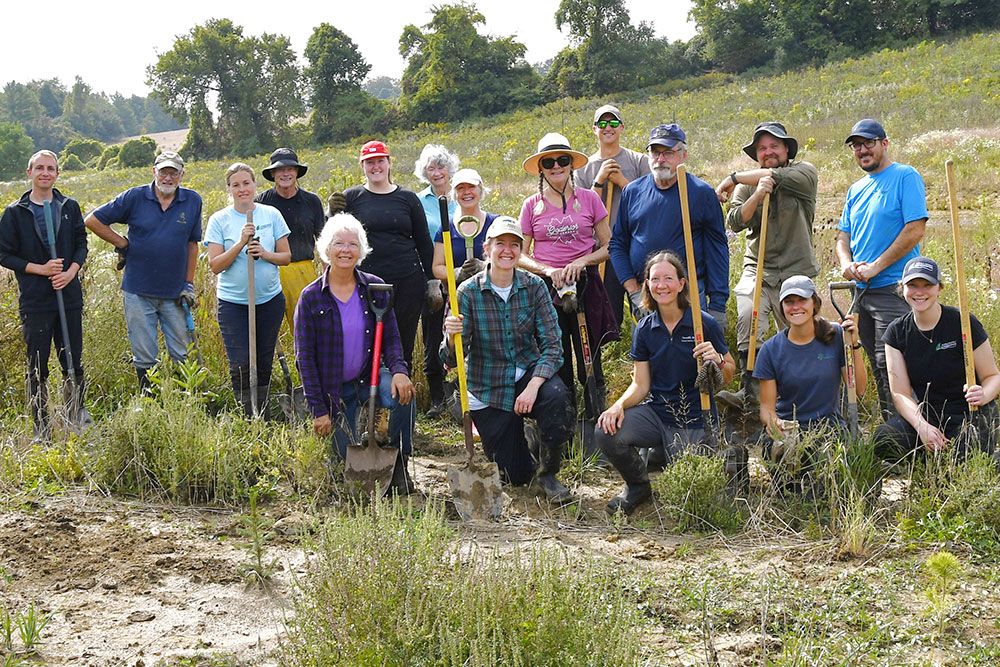Volunteers help plant 1,000 plants at wetland site

Community members help to plant 1,000 plants at Oakes family property wetlands near Holmesville
Volunteers helped to plant 1,000 wetland-friendly plants at a local property owner’s wetland project near Holmesville. The planting at the Oakes family property took place on Monday, September 22, 2025.
Members of the Goderich Lions Club, local residents, and a retiree from Ducks Unlimited Canada, were among the volunteers who took part. Also planting native species of plants at the wetland restoration were staff from Ausable Bayfield Conservation, Maitland Conservation, County of Huron, and Huron Stewardship Council.
Rachel White is Stewardship Coordinator with Huron Stewardship Council (HSC). “We are going to plant about 1,000 plants,” she said at the planting event. “These will help diversify the wetland, help wildlife, and filter water.” About 18 people generously gave of their time to help, she said.
Angela Van Niekerk is Wetlands Specialist at Ausable Bayfield Conservation Authority (ABCA). Those taking part planted native species of plants at three of six wetlands on the property. The plants included pollinator plants for bees, moths, and butterflies. The plant species included Joe-pye Weed; Tall Sunflower; Sweet Oxeye; Blue Flag; Dense Blazing Star; and Cardinal Flower. “They’re native plants so they are used to our weather conditions; heavy rains and drought,” she said.
Wetland projects like this one can only happen thanks to the support of participating landowners like the Oakes family, Van Niekerk said. They have turned about 18 acres of their property into natural habitat through planting of trees and native species of shrubs and wetland plants.
Most wetland enhancement projects are completed on the properties of landowners who choose to enhance these areas or retire a section of their property to build up the natural features. These enhancements provide benefits for water quality and water quantity and wildlife habitat.
Over the ensuing months, it is expected there will be more wildlife at the wetland. A wider diversity of habitats and plants attract more deer, birds, and insects, such as dragonflies, that call the wetland home and as the plants grow the wetland will become more robust.
PHOTO CAPTION CUTLINE: IMPROVING WATER QUALITY AND ENHANCING WILDLIFE HABITAT AT LOCAL WETLANDS – Shown after planting 1,000 wetland-friendly plants, all native species of plants, at the Oakes family’s property near Holmesville, are: (front row, left to right): Margaret Kroes, volunteer; Rachel White, Huron Stewardship Council (HSC); Angela Van Niekerk, Ausable Bayfield Conservation Authority (ABCA); Shannon Millar, Maitland Valley Conservation Authority (MVCA); Ellen Westelaken, ABCA; and (back row, left to right), Sheldon Paul, HSC; Peter Shephard, volunteer with Goderich Lions; Cristen Watt, ABCA; Richard Keeso, volunteer; Derry Wallis, County of Huron; Marian Shephard, volunteer; Lynette Crawford Mader, a volunteer and retiree of Ducks Unlimited Canada; Laurie Spate-Smith, volunteer; Derek Dolmage, ABCA; Stephen Bidwell, Volunteer; Ben Riggin, ABCA; and Adam Youngblut, MVCA. Also helping out was volunteer Renee Sandelowsky (not in photo).